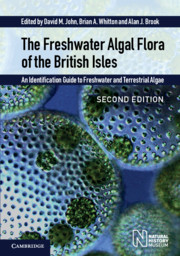 The Freshwater Algal Flora of the British Isles
The Freshwater Algal Flora of the British Isles Published online by Cambridge University Press: 12 January 2024
The primitive green algae may be classified into three classes, the Pedinophyceae, the Prasinophyceae and the Charophyceae. The class name Prasinophyceae (Christensen, 1962) is based on the Greek word prason (πράσου), meaning a leek. It refers to the yellowish green colour of the cell in many prasinophyceans, reflecting the presence of pigments which are slightly different from those of most other green algae. Prasinophycean green algae are mainly flagellates. The cell surface and the flagella are commonly covered with minute organic scales, but these are usually too small to be visible under the light microscope (exception: the largest scales in Mesostigma). Therefore, for critical species determination, scale structure often needs to be ascertained by electron microscopy. In some genera all traces of scales have been lost and recently an increasing number of minute flagella-lacking species of themarine picoplankton have been proved by gene sequencing to be prasinophyceans. Prasinophyceans are generally accepted to be the oldest group of green algae fromwhose ancestors all other groups of green algae have arisen (in cladistic terms they constitute a paraphyletic group of green algae). They are thought to be very ancient, a theory also based on the presence of prasinophycean-like cells in fossil material dating perhaps as far back as the Precambrian.
Ultrastructurally, the flagellated prasinophyceans usually have parallel and notably long flagellar bases, which are inserted in a groove. The genera are morphologically very different, probably reflecting the ancient origin of the group; thus the number of flagella varies from zero or one in a few genera, to 2 and 4 in several genera, to 8 and even 16 flagella in one species, the only 16-flagellated algal flagellate known. The total number of extant species is probably around 100.
The ultrastructural features separating the prasinophytes from the chlorophytes, eustigmatophytes and raphidophytes are not distinguished using the light microscope. For this reason the prasinophyte genera are keyed out with other flagellates in Section IV of the keys to chlorophytes (principally Volvocales) and the phyla mentioned above (see p. 367).
CLASS PEDINOPHYCEAE
The Pedinophyceae, so named by Moestrup (1991), comprises 3 genera of small, naked (scale- or wall-less) flagellates, with around 10–15 species. The cells show a number of unusual traits, e.g. during mitosis in Pedinomonas, where the nuclear envelope remains intact throughout, surrounding the entirely internal spindle apparatus.
To save this book to your Kindle, first ensure [email protected] is added to your Approved Personal Document E-mail List under your Personal Document Settings on the Manage Your Content and Devices page of your Amazon account. Then enter the ‘name’ part of your Kindle email address below. Find out more about saving to your Kindle.
Note you can select to save to either the @free.kindle.com or @kindle.com variations. ‘@free.kindle.com’ emails are free but can only be saved to your device when it is connected to wi-fi. ‘@kindle.com’ emails can be delivered even when you are not connected to wi-fi, but note that service fees apply.
Find out more about the Kindle Personal Document Service.
To save content items to your account, please confirm that you agree to abide by our usage policies. If this is the first time you use this feature, you will be asked to authorise Cambridge Core to connect with your account. Find out more about saving content to Dropbox.
To save content items to your account, please confirm that you agree to abide by our usage policies. If this is the first time you use this feature, you will be asked to authorise Cambridge Core to connect with your account. Find out more about saving content to Google Drive.